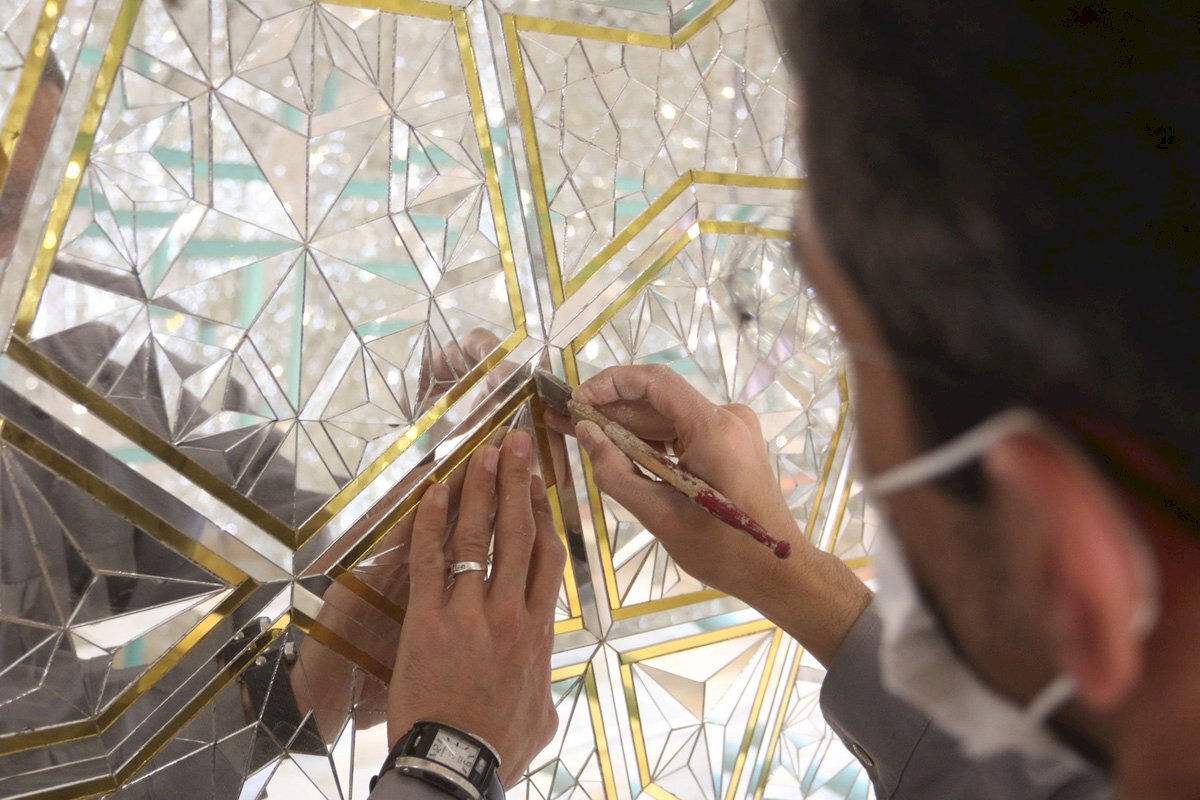TEHRAN – Ayeneh-kari, the captivating Iranian art of embedding mirrored glass in plaster, transforms interiors into shimmering masterpieces.
This ancient craft, weaving geometric, floral, and calligraphic designs, not only enchants the eye but also preserves Iran’s rich cultural heritage through its radiant, reflective beauty.
The art form is not only aesthetically captivating but also serves a practical purpose as a durable covering for interior spaces.
According to Iranica, Venetian glassmakers in the 15th century pioneered the production of small mirrors by cutting open blown glass cylinders, which were then polished and silvered. By 1507, they perfected a method using an amalgam of tin and mercury to coat sheets of glass, leading to the production of plate glass in the late 17th century. In contrast, Persian glassmaking had declined to the point of resmelting old glass, producing an inferior product. However, the Safavid monarch Shah Abbas I revitalized the industry by inviting Venetian glassmakers to Iran, marking a significant turn in Persian decorative arts.
During the Qajar period, Ayeneh-kari flourished as a prominent decorative element. Imported European mirrors, often rectangular with elaborate glass frames, were used as luxurious focal points or as complete mirrored revetments on facades. These mirrors were utilized to adorn facades that marked the transition from exterior to interior spaces, creating a dazzling interplay of light and reflections. An exemplary early instance of Ayeneh-kari can be seen in the 17th-century Chehel Sotun Palace in Isfahan, showcasing the opulence and sophistication of this art form.
Safavid monarch Shah Abbas I revitalized the industry by inviting Venetian glassmakers to Iran, marking a significant turn in Persian decorative arts.The Zand and Qajar periods witnessed a widespread adoption of mirror decoration in various architectural elements such as portals, overdoors, window frames, walls, ceilings, and columns. This technique was employed in pavilions, private houses, tea houses, royal buildings, shrines, and Zurkhanehs—traditional sports venues. Multiple mirrors with etched and painted glass frames provided the traditional rectangular units for facades, creating a harmonious blend of art and architecture.
In the Pahlavi period, Ayeneh-kari found its most notable expression in modern equivalents of traditional Iranian architectural elements such as talars (porches or halls) and iwans (rectangular vaulted spaces open on one side). These structures incorporated mirrored glass to enhance their visual appeal, maintaining the legacy of Ayeneh-kari in contemporary architecture.
The process of Ayeneh-kari is meticulous and labor-intensive. Artists begin by designing the patterns, drawing inspiration from geometric shapes, floral motifs, and calligraphic scripts. Once the design is finalized, the mirrors are carefully cut into the required shapes and sizes. These mirror pieces are then meticulously arranged and embedded into a layer of plaster applied to the surface. The precision required in placing each fragment ensures that the final result is a cohesive and dazzling mosaic of reflective glass.
It is important to consider that Ayeneh-kari is not just a decorative art; it embodies the cultural and historical heritage of Iran. The reflective surfaces created through this technique are symbolic, often associated with divine light and spiritual illumination. The interplay of light and reflection in Ayeneh-kari can transform a space, creating a sense of grandeur and serenity. This art form has been used to adorn mosques, palaces, and mausoleums, imbuing these spaces with an ethereal quality.
Despite the passage of time, Ayeneh-kari continues to captivate and inspire. Modern interpretations of this traditional craft can be seen in contemporary Iranian architecture and interior design.
Today, the associated crafters are finding innovative ways to incorporate mirrored glass into modern spaces, blending tradition with modernity. The enduring appeal of Ayeneh-kari lies in its ability to create beauty through light and reflection, a testament to the ingenuity and artistic prowess of Iranian craftsmen.


No comments:
Post a Comment